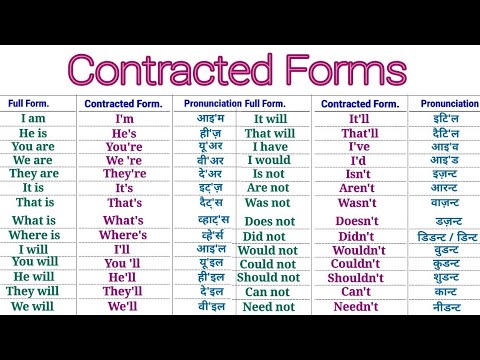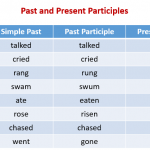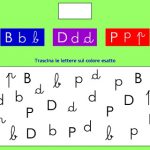Ecco qui un altro articolo per insegnare e imparare inglese sulla rete
In inglese sono molto comuni le forme contratte dei verbi.
In questo articolo vedremo le più comunemente usate e accettate nella grammatica inglese, concentrandoci soprattutto sulle forme del presente e del passato.
Questo è un argomento che affrontiamo nelle lezioni di inglese a livello principiante, anche nei corsi per bambini, perchè in inglese la forma contratta è veramente frequente e si può incontrare tutti i giorni.
Tenete conto che, nella lingua parlata, l’uso di contrarre le forme verbali è assai vasto e va anche ben oltre quanto contemplato sui manuali di grammatica.
Il nostro primo consiglio è sempre quello di ascoltare, ascoltare, ascoltare. Solo cosi potrete arrivare ad una ottima comprensione all’ascolto. E tenete sempre in mente che una cosa è la lingua dei libri, ben altra quella che (in forma orale o scritta) viene “spesa” tutti i giorni.
Per non evitare errori, se non siete sicuri, potete evitare le forme contratte…ma il risultato sarà un pochino “strano”. Per farvi avere una idea di quanto strano, date una occhiata a questa clip
“YOU ARE the father of Jane and Michael Banks, ARE YOU NOT?”
Se avesse detto “You’re the father of Jane and Michael Banks, aren’t you?” il tutto sarebeb suonato molto piuì normale e colloquiale…ma ci saremmo fumati una delle scene piuì esilaranti del film.
Mary Poppins, tata assertiva, parla quasi sempre senza forme contratte!
Contenuti di questa pagina
Forme grammaticali e forme contratte
Tenete in mente queste regole grammaticali:
- la forma contratta si usa alla forma affermativa (versione abbreviata del verbo)
- la forma contratta si usa alla forma negativa. Si può incontrare sia la contrazione tra soggetto e verbo (YOU’RE NOT) che tra verbo e NOT (YOU AREN’T)
- la forma contratta NON si usa alla forma interrogativa
- la forma contratta viene segnalata dall’apostrofo
Verbo TO BE – simple present – forma affermativa contratta
Cominciamo a vedere la coniugazione del verbo TO BE (simple present)
Forma affermativa TO BE – Forma contratta
| Forma affermativa verbo TO BE | Forma contratta |
| I AM | I’M |
| YOU ARE | YOU’RE |
| HE/SHE/IT IS | HE/SHE/iT’S |
| WE ARE | WE’RE |
| YOU ARE | YOU’RE |
| THEY ARE | THEY’RE |
Da alcuni anni mi rivolgo a Open Minds per l’organizzazione di lezioni per i miei figli di 10 e 13 anni. Ho scelto lezioni singole o a piccoli gruppi.
Mi sono sempre trovata molto bene sia con gli insegnanti (professionali, simpatici, puntuali), sia con la gestione della parte amministrativa (disponibilità e cortesia).
Roberta Pasin
Forma negativa contratta del verbo TO BE
Ci sono due opzioni: entrambe corrette.
La prima versione del verbo contratto contrae soggetto+verbo (I am–> I’m) e lascia intera la negazione (I’m not), l’altra contrare verbo+not(non esiste la prima persona, ma lo puoi vedere dalla seconda persona in poi You are not –> You aren’t)
Vediamo nella tabella che segue tutte le forme di entrambe le versioni della contrazione negativa del verbo essere
| Forma negativa verbo TO BE | Forma contratta 1 | Forma contratta 2 |
| I AM NOT | I’M NOT | |
| YOU ARE NOT | YOU’RE NOT | YOU AREN’T |
| HE/SHE/IT IS NOT | HE/SHE/IT’S NOT | HE/SHE/IT ISN’T |
| WE ARE NOT | WE’RE NOT | WE AREN’T |
| YOU ARE NOT | YOU’RE NOT | YOU AREN’T |
| THEY ARE NOT | THEY’RE NOT | THEY AREN’T |
Ascoltiamo qui una video lezione che ci spiega questi meccanismo di contrazione dei verbi inglesi.

Verbo TO DO – simple present-forma contratta
Il verbo TO DO può avere la forma contratta solo nelle frasi negative.
| Forma negativa verbo TO DO | Forma contratta |
| I DO NOT | I DON’T |
| YOU DO NOT | YOU DON’T |
| HE/SHE/IT DOES NOT | HE/SHE/IT DOESNìT |
| WE DO NOT | WE DON’T |
| YOU DO NOT | YOU DON’T |
| THEY DO NOT | THEY DON’T |
Verbo CAN – simple present – forma contratta
Il verbo CAN può avere la forma contratta solo nelle frasi negative.
| Forma negativa verbo CAN | Forma contratta |
| I CANNOT | I CAN’T |
| YOU CANNOT | YOU CAN’T |
| HE/SHE/IT CANNOT | HE/SHE/IT CAN’T |
| WE CANNOT | WE CAN’T |
| YOU CANNOT | YOU CAN’T |
| THEY CANNOT | THEY CAN’T |
A che punto sei con l’inglese?
Forme progressive contratte in inglese
Il verbo to be è l’ausiliare nelle forme progressive o continue (present continuous, past continuous…), ovvero tutte quelle forme verbali che vengono formate da TO BE + ING FORM.
Le contrazioni del verbo TO BE come verbo ausiliare sono fatte esattamente come nel verbo TO BE semplice.
Esempio: il present continuous si forma con la forma TO BE al simple present + ING form
I AM WRITING = I’M WRITING
YOU ARE NOT WRITING = YOU’RE NOT WRITING/ YOU AREN’T WRITING
Forme composte contratte in inglese
Il verbo to have è l’ausiliare nelle forme composte (present perfect, past perfect…), ovvero tutte quelle forme che vengono formate da TO HAVE + PARTICIPIO PASSATO.
Le contrazioni del verbo TO HAVE come verbo ausiliare sono fatte esattamente come le forme del verbo TO HAVE semplice.
Esempio: present perfect
I HAVE WRITTEN = I ‘VE WRITTEN A LETTER
YOU HAVE NOT WRITTEN A LETTER= YOU ‘VE NOT WRITTEN/ YOU HAVEN’T WRITTEN A LETTER
Forme contratte al passato semplice
Le forme del passato inglese possono essere contratte?
Ma certo! Diamo una occhiata:
- tempi semplici: DO come ausiliare dei passati nei tempi semplici (DID- simple present) può essere contratto nella forma negativa (DID + NOT)
| Forma negativa DID | Forma contratta |
| I DID NOT | I DIDN’T |
| YOU DID NOT | YOU DIDN’T |
| HE/SHE/IT DID NOT | HE/SHE/IT DIDN’T |
| WE DID NOT | WE DIDN’T |
| YOU DID NOT | YOU DIDN’T |
| THEY DID NOT | THEY DIDN’T |
Hai trovato utile la nostra spiegazione? Se la hai trovata chiara, sappi che facciamo bellissime lezioni di inglese online per bambini e per adulti.
Puoi contattarci per un preventivo del coerso personalizzato online, in diretta con il docente madrelingua, oppure per sapere come iscriverti al nostro corso su piattaforma, che coniuga la supoer -flessibilità al risparmio.
Ti consigliamo in ogni caso di iscriverti alla newsletter per ricevere le informazioni, gli aggiornamenti ed i materiali gratuiti.
Qui puoi fare esercizi online gratuiti sulle forme contratte del verbo inglese
E ti ricordiamo i nostri corsi di inglese
A presto









Lascia un commento